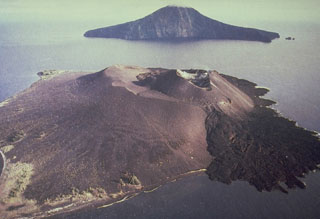Report on Krakatau (Indonesia) — 3 August-9 August 2022
Smithsonian Institution / US Geological Survey
Weekly Volcanic Activity Report, 3 August-9 August 2022
Managing Editor: Sally Sennert.
Please cite this report as:
Global Volcanism Program, 2022. Report on Krakatau (Indonesia) (Sennert, S, ed.). Weekly Volcanic Activity Report, 3 August-9 August 2022. Smithsonian Institution and US Geological Survey.
Krakatau
Indonesia
6.1009°S, 105.4233°E; summit elev. 285 m
All times are local (unless otherwise noted)
PVMBG reported that the eruption at Anak Krakatau continued during 3-9 August. Several eruptive events occurred on 3 August (at 0034, 0115, and 1540), sometimes producing dense black ash plumes that rose as high as 1.5 km above the summit and drifted SW. At 0926 on 4 August a dense gray-to-black ash plume rose 1.5 km and drifted N. Incandescence at or near the vent was seen in nighttime photos on most days. Diffuse white plumes were visible rising from the volcano during 7-8 August. The Alert Level remained at 3 (on a scale of 1-4), and the public was warned to stay at least 5 km away from the crater.
Geological Summary. The renowned Krakatau (frequently mis-named as Krakatoa) volcano lies in the Sunda Strait between Java and Sumatra. Collapse of an older edifice, perhaps in 416 or 535 CE, formed a 7-km-wide caldera. Remnants of that volcano are preserved in Verlaten and Lang Islands; subsequently the Rakata, Danan, and Perbuwatan cones were formed, coalescing to create the pre-1883 Krakatau Island. Caldera collapse during the catastrophic 1883 eruption destroyed Danan and Perbuwatan, and left only a remnant of Rakata. This eruption caused more than 36,000 fatalities, most as a result of tsunamis that swept the adjacent coastlines of Sumatra and Java. Pyroclastic surges traveled 40 km across the Sunda Strait and reached the Sumatra coast. After a quiescence of less than a half century, the post-collapse cone of Anak Krakatau (Child of Krakatau) was constructed within the 1883 caldera at a point between the former Danan and Perbuwatan cones. Anak Krakatau has been the site of frequent eruptions since 1927.
Source: Pusat Vulkanologi dan Mitigasi Bencana Geologi (PVMBG, also known as CVGHM)

